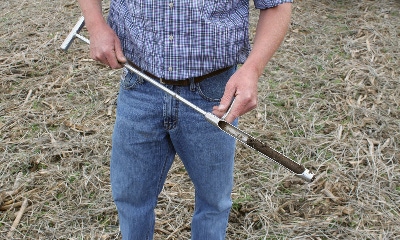April 13, 2016

Soybean planting is just weeks away, and it is important to test your fields for soybean cyst nematodes now before planting. SCN is a major concern to growers throughout the state as these plant-parasitic round worms invade the plant roots and suck nutrients from the plants, decreasing their ability to produce adequate yields.
The challenge with preventing SCN is that infected plants do not easily express symptoms. Fields can sustain up to 30% yield loss due to SCN without displaying any symptoms, making sampling the only way to identify a problem that you might not actually be seeing.

TIME TO SAMPLE: Collecting soil samples will determine SCN levels. (Photo courtesy United Soybean Board)
Producers often ignore the possibility of SCN because they plant resistant varieties, but it is important to realize that SCN can adapt to the resistance lines if the same resistant seed source is used year after year.
Amanda Howland, the new coordinator for the MU Extension Plant Nematology labs, says 87% of the soil samples received since January 1, 2015 tested positive for having SCN, with egg counts ranging from 100 to over 100,000 eggs per cup of soil (250 cc3). Roughly 25% of the total samples tested had more than the threshold value of 10,000 SCN eggs/cup of soil. This proves it is important to sample soybean fields and check SCN egg counts periodically (every three years) to monitor whether the egg counts are increasing.
Although typically fall is the best time to check fields for SCN because the results will be available for use in making decisions and plans for the next growing season, especially in terms of crop rotation and soybean variety selection, it is still not too late to sample the fields now ahead of planting.
Since SCN egg counts are only as good as the sample taken, here are 4 tips for sampling for SCN:
1. Limit the size of the area being sampled: 10 - 20 acres is a good target.
2. Using a bucket and probe or shovel, walk the area in a W or Z pattern, sampling about 8 inches deep in the root zone between the rows. Take about 20 cores (with a shovel take ¼ cup of soil from near the shovel tip). Mix the cores well into a composit e sample, and bag about a pint of the soil for submission. Do not let the samples dry out. Nematodes are sensitive to heat. Do not leave samples in the sun or other areas of high temperature.
3. Label the plastic bag and ship it as soon as possible.
4. Fill out a submission form (available from at soilplantlab.missouri.edu/nematode or your local extension agent) or on a piece of paper indicate:
-Name, address, phone, and email (if you have email, results can be sent quickly)
-County and cropping history
-Type of test: SCN egg count ($20), modified HG type test (In state: $75; Out of state: $125),full HG type test(In state: $100; Out of state: $150), or Plant-Parasitic Nematode Analysis which includes plant-parasitic nematodes identification ($30)
-Mail to Plant Nematology Lab, 23 Mumford Hall University of Missouri, Columbia, MO 65211
Source: MU-IPM Newsletter
You May Also Like




